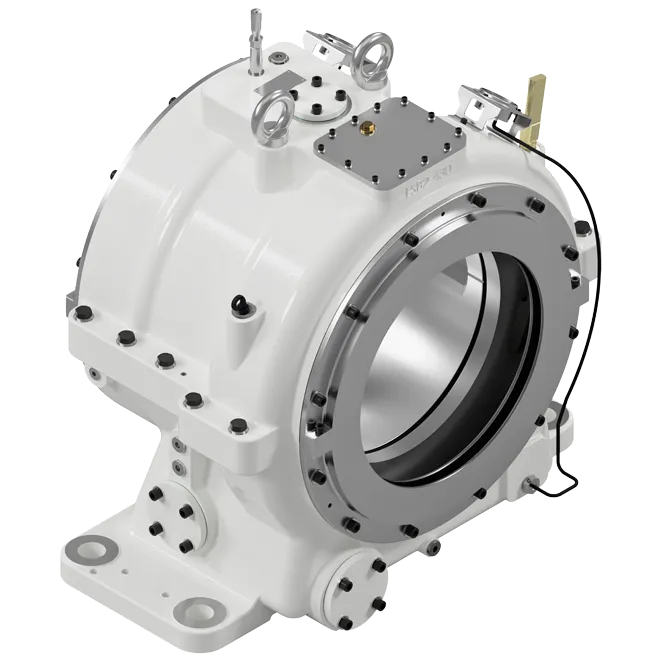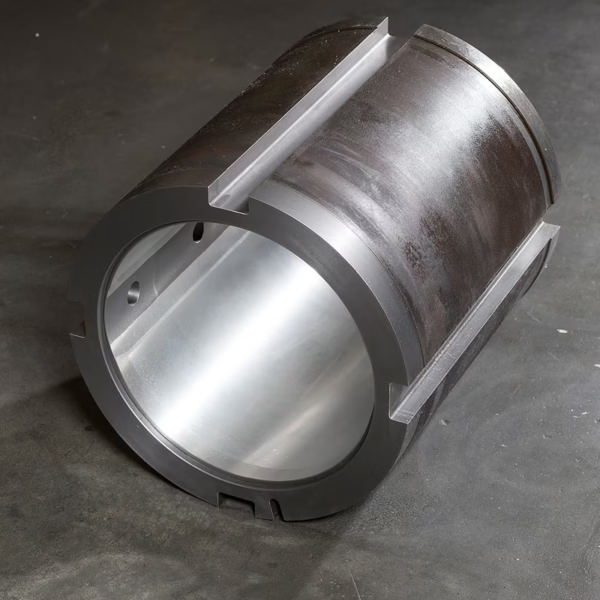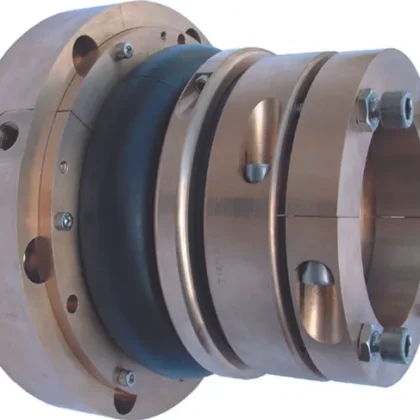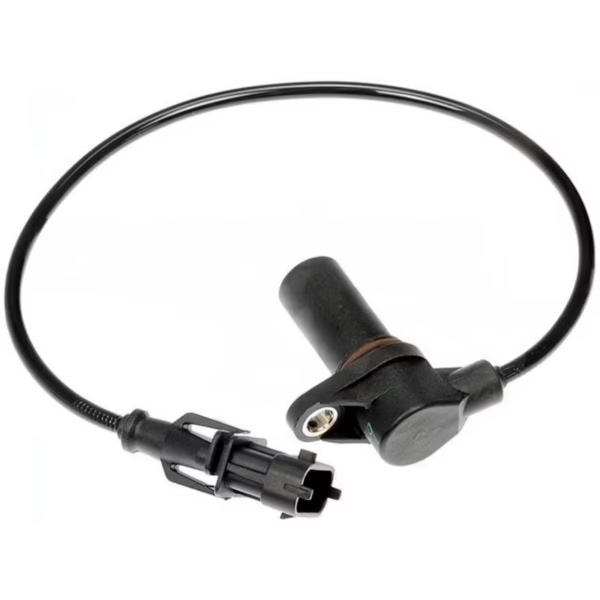A marine sliding intermediate bearing, also known as a line shaft bearing or plummer block bearing, is a critical component of a ship’s propulsion system. It is positioned between the thrust bearing and the stern tube bearing to support the weight of the intermediate shaft sections and maintain their precise alignment. This ensures that the propeller shaft rotates smoothly without sagging or vibrating excessively, which could cause catastrophic damage to the entire propulsion system.
The term “sliding” refers to the type of bearing, a plain bearing, where the shaft rotates on a sliding surface of a soft metal rather than on rolling elements like balls or rollers. This design is highly reliable and well-suited to the heavy loads and low speeds typical of ship propulsion.
Design and Function
A typical marine sliding intermediate bearing is a robust, cast housing, often split horizontally for ease of installation and maintenance without having to withdraw the entire shaft.
- Bearing Shells: The main components are the upper and lower bearing shells, which are typically made of cast iron and lined with a layer of white metal (Babbitt metal). This soft alloy provides a low-friction surface that is forgiving of minor misalignment and helps to absorb shock.
- Lubrication: These bearings are usually lubricated by a continuous oil supply. The lubrication method can vary, from a simple oil bath or an oil ring that dips into a sump, to a more complex forced lubrication system. The bearing housing often includes a cooling water coil to prevent overheating.
- Split Design: The “sliding” or split design allows for the bearing shells to be unbolted and removed or inspected without having to dismantle the entire shaft line, which is a major advantage for maintenance in a cramped shaft tunnel.
Common Spare Parts
Due to the nature of the bearing material, spare parts are crucial for both planned overhauls and unexpected failures.
- Bearing Shells: Complete upper and lower bearing shells are the most important spare part. Over time, the white metal lining will wear, and the bearing shells must be replaced or re-metalled.
- White Metal Inserts: Some bearings allow for the replacement of just the white metal lining, which can be scraped and fitted to the shaft to achieve the correct running clearance.
- Oil Seals: Gaskets and oil seals are vital to prevent the lubricating oil from leaking from the bearing housing.
- Lubrication System Components: Spares for the lubrication system, such as oil rings, pipes, and cooling coils, are often kept on hand.
- Monitoring Instruments: Spares for temperature sensors (RTDs or thermocouples) and oil level indicators are important for condition monitoring.
Maintenance and Importance
Proper maintenance is paramount for the longevity of a sliding intermediate bearing.
- Alignment: Ensuring the bearing is in perfect alignment with the rest of the shaft line is a critical, and often challenging, task. Misalignment can lead to excessive wear and even failure.
- Lubrication: The lubrication system must be monitored continuously to ensure a constant supply of clean oil at the correct temperature.
- Condition Monitoring: Routine monitoring of bearing temperature and vibration levels can provide early warnings of a problem, such as wear or lubrication failure.
- Periodic Inspection: The bearings are typically inspected during dry-docking to measure wear and confirm the bearing clearance is within acceptable limits.
A well-maintained sliding intermediate bearing is essential for the smooth, reliable, and safe operation of a ship’s propulsion system.
We offer an extensive range of marine engine brands and their associated spare parts, providing comprehensive solutions for both main propulsion and auxiliary power needs across diverse vessel types. Our supply capability covers various generations and models, ensuring support for a wide array of marine applications.
Featured Brands and Engine Series/Models:
SULZER:
- Two-Stroke Engines:
- RD/RND Series: RD68, RND76, RND76M, RND90, RND90M (Classic large-bore, low-speed engines, still in operation).
- RLA/RLB Series: RLA(B)56, RLA(B)66, RLA(B)76, RLB90 (Developed two-stroke designs).
- RTA/RT-Flex Series: RTA38, RTA48(T), RTA52, RTA58, RTA62, RTA72, RTA76, RTA84, RTA84M, RTA84C, RTA96 (Modern, fuel-efficient, electronically controlled two-stroke engines).
- Four-Stroke Engines:
- Z Series: ZL40/48, 16ZAV40S (Medium-speed engines).
- RF Series: RF44, RF56 (Often used for auxiliary power or generator sets).
- TAD Series: TAD36, TAD48 (For specific applications).
MAN (including pre and post-MAN B&W models):
- Two-Stroke Engines (KZ, KSZ, K, L, S, MC/MC-C, ME/ME-C): 40/54A, 52/90N, 57/80C, KZ57/80F, KSZ70/125, KSZ78/155, 90/160A, 52/55L, 58/64, 90/190C, L60/105E, 70/120E, 70/125C, L, KSZ78/155A, KSZ70/125B, L52/55A, 40/45 (A broad spectrum covering main propulsion and auxiliary engines).
B&W (Burmeister & Wain – prior to MAN B&W merger):
- MC/MCE Series: L35MC, L60MC, L80MC, L55GFCA, L80GFCA, L80GB, 74VT2BF, K62EF, K74EF, K84EF, K45GFC, K67GFK, K80GFK, K90GFS, 45HU, L70MC (Various generations of two-stroke diesel engines).
- MC-C/ME-C Series: L50MC, S60MC, S70MC, K80MC, S80MC, K90MC-C, L67GFCA, L90GB (Electronically controlled and conventional two-stroke engines).
- VT2BF/EF Series: 50VT2BF, 62VT2BF, K84EF (Older models still in service).
MITSUBISHI:
- UEC/UET Series: UEC37L/LA/LS, UEC45HA, UEC60L/LA/LS, UEC45L/LA/LS, UET45/75C, UEC52/125H, UEC52L/LA/LS, UET45/80D, UEC52/90D, UEC(T)52/105D, UEC45/115H, UEC37/88H, UEC37H (Mitsubishi’s proprietary two-stroke and some four-stroke engine series).
PIELSTICK:
- PA Series: PA6, PC3, PC2-2, IHI PC2-5, PC4, PC2-6, PC4-2L, PC4-570, PA5 (High-speed, compact four-stroke engines, commonly used for generator sets or auxiliary propulsion).
AKASAKA:
- UET/UEC/DM/AH Series: UET45/80D, UEC52/105D, DM51SS, UEC 60/150H, UEC 60H, A31, A34, A37, A41, AH27, AH28, AH30, AH36, AH38, AH40, DM30, DM36, DM38, DM46, DM47 (A prevalent engine brand, particularly in Japanese-built vessels).
DEUTZ:
- RBV/TBD/BVM Series: RBV8M358, RBV8M540, RBV16M640, TBD620L6, BVM350, BVM540, BF6M716 (Various four-stroke medium- and high-speed diesel engines for auxiliary and smaller main propulsion applications).
HANSHIN:
- EL/LH/LU/LUN/LUD/LUS Series: EL30, EL32, EL35, EL40, EL44, LH28RG, LH31G, LU28(A,R,G), LU32, LU35, LU38, LU46(A), LU50, LU54, LUN28, LUN30, LUD32, LUD35, LUS38 (Another significant engine brand commonly found in Japanese vessels).
NIIGATA:
- MG/M Series: MG40X(EX), M34X, 6M28BF, TM31X (Medium-speed diesel engines, typically used in small and medium-sized vessels).
MAK:
- M/MU/AK/AKM Series: M332, M453AK, MU551AK, MU552AK, M601, MU452AK, 451AK, 6M453AK, 9M453C, 6M601C, 8M601 (Medium-speed four-stroke engines, widely used in various marine applications).
WARTSILA:
- 20/22/26/32/38/46/GD/TKR Series: 22, 32, 31, 26, 20S, 28, 38, 46, 32GD, 46GD, 14, TKR22, HFR-V32, NOHAB (Wärtsilä’s broad portfolio of medium- and high-speed diesel engines for main propulsion, auxiliary, and generator sets).
DAIHATSU:
- PS/PKT/DS/DL/DK/PL Series: PS-18, PS-22, PS-20, PS-26, PS-30, PKT-14, PKT-16, PKTD-16, DS-18, DS-22, DS-26, DS-28, DS-32, DL-14, DL-16, DL-19, DL-20, DL-22, DL-24, DL-26, DK-20, PL-24 (Compact and reliable engines primarily used for auxiliary power and generator sets).
CUMMINS:
- BT/CT/NT/KTA/QSK/QSM Series: 4BT3.9, 6BT(A)5.9, 6CT8.3, NT(A)855, N14, KTA19, KTA38, KTA50, QSK19, QSM11 (Robust and durable engines for marine auxiliary power, generator sets, and some smaller main propulsion applications).
CATERPILLAR:
- 3000/3100/3300/3400/3500/3600 Series & C Series: 3054, 3056, 3066, 3106, 3126, 3306, 3406, 3408, 3412, 3508, 3512, 3516, 3606, 3608, 3612, 3616, 3618, C1.5, C2.2, C7, C9, C10, C12, C15, C16, C18, C30, C32 (Reliable and widely used engines across a vast range of main propulsion, auxiliary, and generator set applications).
SCANIA:
- DI Series: DI 09, DI 13, DI 16 (High-performance diesel engines designed for marine applications, typically used as auxiliary and smaller main propulsion engines).




